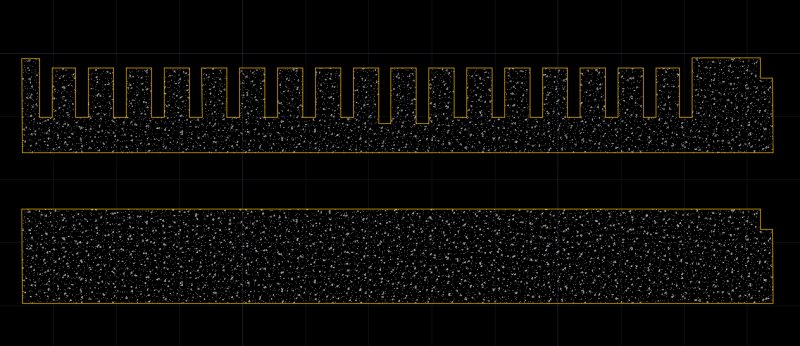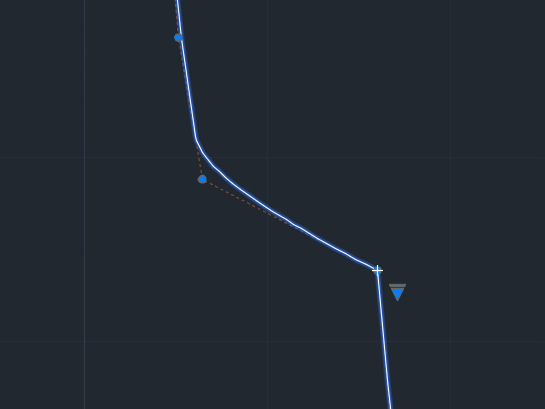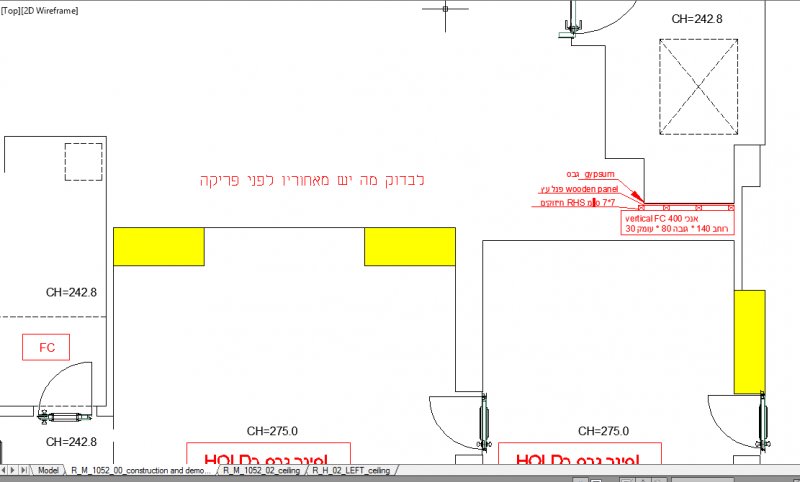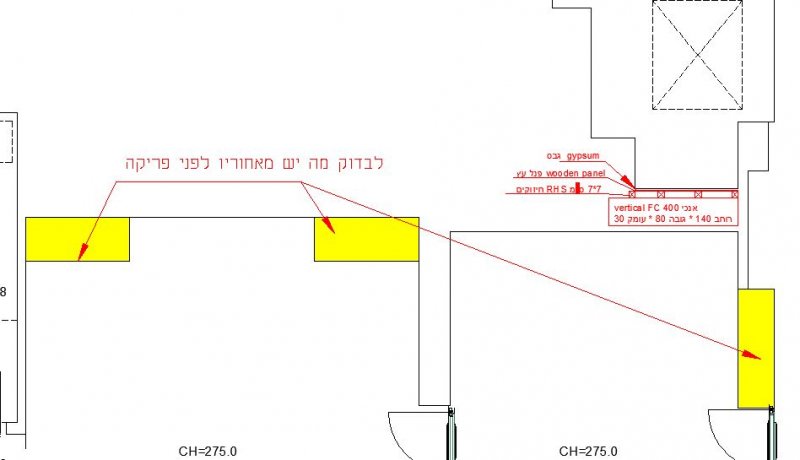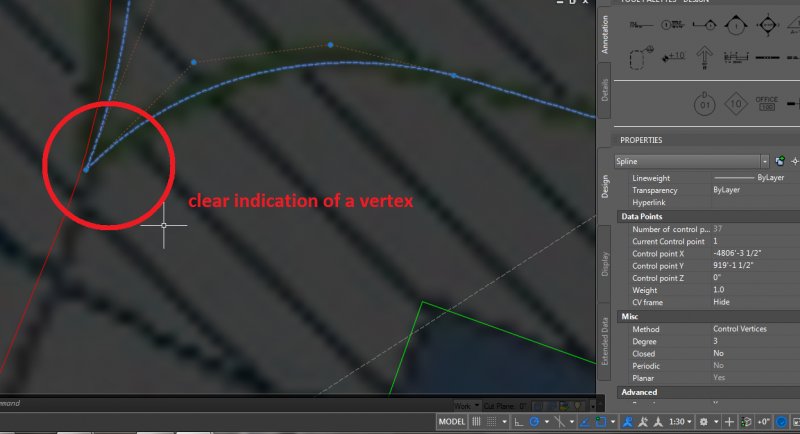Search the Community
Showing results for tags 'vertex'.
-
Lisp To Magnetize Polyline Vertex To a Point
DueEastTrav posted a topic in AutoLISP, Visual LISP & DCL
I am looking for a way to readily magnetize polyline vertex to a point. Any idea? Thank you. -

Intersections Between Lines at different Elevations
Jaru posted a topic in AutoLISP, Visual LISP & DCL
Hi There is a situation what I need is a lisp routine or vba script to find the elevations between lines or polylines at the intersection points of them to better reflect my query I post an image. I thank you in advance for the help provided. Elevation-Case.bmp -
I have found the following at the swamp, however I would like to modify it to better suite my needs. All credits to Lyle Hardin for writing the awesome code. ;;; CADALYST 08/08 www.cadalyst.com/code ;;; Tip 2305: LeaderToMleader.lsp Leader to Multileader (c) 2008 Lyle Hardin ;;; Pick an old style leader and text to create a new mleader entity and erase the old leader and text. ;;; March/2008 (defun c:leadertomleader () (setq leader (entsel "\nPick Leader") ; pick leader leader2 (entget (car leader)) pt1 (dxf 10 leader2) ; get first point of leader layer (dxf 8 leader2) ; get layer of leader mtext (entsel "\nPick Text") ; pick text mtext2 (entget (car mtext)) pt2 (dxf 10 mtext2) ; get point of text text (dxf 1 mtext2) ; get ) ; setq (command "-layer" "s" layer "") ; set layer of leader picked to current (command "mleader" pt1 pt2 text) ; start mleader command (COMMAND "ERASE" mtext "") ; erase text picked (command "erase" leader "") ; erase leader picked ) ; defun (defun dxf(code elist) ; define dxf function (cdr (assoc code elist)) ;Finds the association pair, strips 1st element );defun So what I would like to do is instead of selecting the insertion point of the mtext as the second point, I would like to change it to the second point of the leader. I've done a little bit of digging around, but all I have found is that the dxf codes for the vertices are 10, resulting in a list: (10 -94274.8 121436.0 0.0) (10 -94274.8 121109.0 0.0) (10 -95313.2 121109.0 0.0) ...(and so on) Hence my question, how do I get the second vertex of the leader? Thanks in advance.
-
Sample.dwg Hi all, I want to write a program which will export the coordinates of vertices for selected polylines with Object Data which corresponds to each polyline. Please refer to a sample drawing attached with this thread. I am happy with this program to export coordinates ; ---------------------------------------------------------------------- ; (Export LWPOLYLINE Vertices & Points to File) ; Copyright (C) 2000 DotSoft, All Rights Reserved ; Website: http://www.dotsoft.com ; ---------------------------------------------------------------------- ; DISCLAIMER: DotSoft Disclaims any and all liability for any damages ; arising out of the use or operation, or inability to use the software. ; FURTHERMORE, User agrees to hold DotSoft harmless from such claims. ; DotSoft makes no warranty, either expressed or implied, as to the ; fitness of this product for a particular purpose. All materials are ; to be considered ‘as-is’, and use of this software should be ; considered as AT YOUR OWN RISK. ; ---------------------------------------------------------------------- ;;Revised 8/23/07 CAB to report coordinates in current UCS (defun c:ptexport () (setq sset (ssget '((-4 . "<OR")(0 . "POINT") (0 . "LWPOLYLINE")(-4 . "OR>")))) (if sset (progn (setq itm 0 num (sslength sset)) (setq fn (getfiled "Point Export File" "" "txt" 1)) (if (/= fn nil) (progn (setq fh (open fn "w")) (while (< itm num) (setq hnd (ssname sset itm)) (setq ent (entget hnd)) (setq obj (cdr (assoc 0 ent))) (cond ((= obj "POINT") (setq pnt (cdr (assoc 10 ent))) (setq pnt (trans pnt 0 1));;**CAB (princ (strcat (rtos (car pnt) 2 "," (rtos (cadr pnt) 2 "," (rtos (caddr pnt) 2 ) fh) (princ "\n" fh) ) ((= obj "LWPOLYLINE") (if (= (cdr (assoc 38 ent)) nil) (setq elv 0.0) (setq elv (cdr (assoc 38 ent))) ) (foreach rec ent (if (= (car rec) 10) (progn (setq pnt (cdr rec)) (setq pnt (trans pnt 0 1));;**CAB (princ (strcat (rtos (car pnt) 2 "," (rtos (cadr pnt) 2 "," (rtos elv 2 ) fh) (princ "\n" fh) ) ) ) ) (t nil) ) (setq itm (1+ itm)) ) (close fh) ) ) ) ) (princ) ) (princ "\nPoint Export loaded, type PTEXPORT to run.") (princ) Now I want to add Object data such as: 1. For polylines on 'LVCable' layer - CSAMetric, Conductor, FeederNo, NoOfCores 2. For polylines on other layers - CSABlue, CSANeutral, CSARed, CSAYellow, FeederNo Thank you Best wishes, Jes G Sample.dwg
- 2 replies
-
- polyline
- object data
-
(and 3 more)
Tagged with:
-
 I had this from Lee, but usually always go way counter-clockwise and only select the polyline, not the point. ;; Polyline Vertex Exporter ~ by Lee McDonnell ~ 26.11.2009 (defun c:pExp2 (/ ss tmp i j ent tot dis pt) (vl-load-com) (if (and (setq ss (ssget '((0 . "*POLYLINE")))) (setq tmp (getfiled "Output File" (cond (*load) ("")) "txt;csv" 9))) (progn (setq *load tmp tmp (open tmp "a") i -1) (write-line "X,Y,Layer" tmp) (while (setq ent (ssname ss (setq i (1+ i)))) (setq tot 0. j (1- (vlax-curve-getStartParam ent))) (while ( (setq pt (mapcar 'rtos (vlax-curve-getPointatParam ent j))) (write-line (strcat (car pt) (chr 44) (cadr pt) (chr 44) (vla-get-layer (vlax-ename->vla-object ent))) tmp)) (write-line "" tmp)) (close tmp))) (princ)) THX for any tips.
I had this from Lee, but usually always go way counter-clockwise and only select the polyline, not the point. ;; Polyline Vertex Exporter ~ by Lee McDonnell ~ 26.11.2009 (defun c:pExp2 (/ ss tmp i j ent tot dis pt) (vl-load-com) (if (and (setq ss (ssget '((0 . "*POLYLINE")))) (setq tmp (getfiled "Output File" (cond (*load) ("")) "txt;csv" 9))) (progn (setq *load tmp tmp (open tmp "a") i -1) (write-line "X,Y,Layer" tmp) (while (setq ent (ssname ss (setq i (1+ i)))) (setq tot 0. j (1- (vlax-curve-getStartParam ent))) (while ( (setq pt (mapcar 'rtos (vlax-curve-getPointatParam ent j))) (write-line (strcat (car pt) (chr 44) (cadr pt) (chr 44) (vla-get-layer (vlax-ename->vla-object ent))) tmp)) (write-line "" tmp)) (close tmp))) (princ)) THX for any tips. -
Sorting mixed order points on a polyline object
nkeseci posted a topic in AutoLISP, Visual LISP & DCL
Hi, Can anyone help me to write a lisp function to sort the points (assume the intersection points) on a polyline? With my code, I have a polyline object and a set of intersection points on it. I need to calculate the cumulative distance between those points and vertex points consecutively. Thanks,- 6 replies
-
- polyline
- intersection
-
(and 3 more)
Tagged with:
-
i am new to all of this. would love to be able to remove all or most vertex's for any and all of my artwork. as for now i need to remove them from a circle. i do not know what the codes are for or how to use them. any help, would help.. i hopesecond sign Y.dxf second sign W.dxf
-
In Maya, it's called soft select. In Blender it's called proportional editing mode. I am looking for a tool that will let me move a grip, causing all of the nearby vertices to move in the same direction. The amount of movement depends on how close it is to the selected grip as well as how sharp you set your falloff. Some videos to give you an idea of what i'm talking about: Soft Select - Proportional Editing - The general idea is that when the user selects a grip, the LISP would search for all valid vertices in the maximum falloff range. Next, when the user moves (or scales, scale would be cool too) that grip, each affected vertex moves in that direction at a percentage of the distance that the target vertex has moved, depending on how close it is to that target vertex. Bonus points if there is also an option that allows the code to only affect lines that are connected to the target vertex by being part of the same polyline. Additional bonus points if the code is heavily commented so that I can see what's going on. This program is way over my head, and I would really love to learn how it would be done. **EDIT** I don't care if it works in 3d or not. I mostly just work with 2d when using AutoCAD.
- 12 replies
-
- soft select
- proportional edit
-
(and 3 more)
Tagged with:
-
Lisp to delete multiple vertices between two points on polyline
Rambojazdude posted a topic in AutoLISP, Visual LISP & DCL
Hi folks. I'm looking for a lisp that effectively straightens out a polyline between two points. I know pedit has the straighten feature but you have to scroll to the points you need straightening between. I've also found that you can break/trim between two points and then rejoin, but ideally I'd like a lisp that does this automatically. It's more of an issue when editing associative hatch boundaries please see attached image for an example of the before and after scenario. Thanks RJD -
Hi! First of all, This is my first post here and I'm not an EXPERT in english, so I will try to explain as good as possible. I'm using Inventor 2012 and AutoCAD Mechanical 2012. In Inventor I have a piece in which it was applied the punching tool (Custom one) it works Perfectly, but when I export it to autoCAD it comes with too many points or vertex, I know if I draw it in autocad I wont have that problem, what that's why we use a Punch Tool, to simplify things and get things easier and always the same. Re-draw is out of the question, unless its the ONLY solution.. We use two CNC Plasma Machine, one of them uses the Software CamBAM and it can edit the vertex and simplifies it and jobs done, but it cant export the job to .dwg or .dxf.. and the second and new machine (the one i'm having trouble) uses FastCAM software, it has something similar to adjust the vertex but, the real problem is within the FastNEST.. Either way, the best solution is to fix the drawing in autocad. EDITPOL doesnt work, as it just joins it, I need to make less points.. I could Upload the file if needed. I'd Really Appreciate any help given. Thanks and Again sorry for my many typos.o:)
-
Hi everyone, I need help with a problem, i speak a little english so i'll try explain me, I need fillet (round) this edges: I tried with manual Fillet/Constant radius and Variable Radius and the result its not satisfactory because the vertex its not perfect, the vertex have imperfections like this: This is with Variable radius: As you seen, the vertex have a sinking surface, and i need the all surfaces/Edges join in a one vertex, I dont care if the radius of the edges is variable. If you need the model i can provide it. Thanks for your help.
- 4 replies
-
- solidworks
- radius
-
(and 3 more)
Tagged with:
-
Hey, I have one vertex not smooth on my drawing. How can I change its tangency? It also shows a "+" sign near it, which I don't know what it means. I attached the drawing here for your reference. Thank you so much!!! vertex problem.dwg
-

Multileader problem- adding new leader to vertex
Sbeth85 posted a topic in AutoCAD 2D Drafting, Object Properties & Interface
Whenever I try to add another leader to my vertex, it usually jumps to the end of the line. Any way to make ALL leader arrows come out of the same vertex? Do I need to adjust my mleaderstyle settings? PS- I recorded a GIF with LICEcap but the File Upload Manager on Cadtutor uploads it as a JPG for some reason.- 1 reply
-
- multileader
- mleaderstyle
-
(and 2 more)
Tagged with:
-
Snapping to vertices on spline
kizaerf posted a topic in AutoCAD 2D Drafting, Object Properties & Interface
I made a spline and there are clear verticies, but autocad just refuses to snap to them. All my osnaps are on and it will snap to some points on the spline but not one where there is a clear vertex. i am stumped. -
When inserting vertex in pline, jump to the new vertex
DieterBvH posted a topic in AutoCAD 2D Drafting, Object Properties & Interface
Hi everyone, I guess I messed up some strange option in AutoCAD here. For my job, I often need to add a number of vertices to a 2D Polyline / edit polylines. Until a couple of days ago, when inserting a new vertex to a polyline, it automatically jumped to the new vertex, so I would add a number of vertices by only using the (insert) command. But now, when inserting a new vertex in a polyline, the X stays on the original vertex, the vertex selected before inserting the new one. So when inserting a number of vertices, I have to press , then (next) for every vertex inserted. The way vertices get inserted now is as if you insert a vertex by pressing , then press for previous so the X jumps back to the original. I'd like to insert a couple of vertices without pressing each time! I have tried to find this option but couldn't find it anywhere. (pline options? Pedit options?) I am using AutoCAD 2010, no mouse commands (only keyboard). Hope someone can help me out here, thx in advance! EDIT: English + more thorough explanaition... -
Exporting in Excel polylines coordinates-vertex and autocad handle
collada999 posted a topic in AutoLISP, Visual LISP & DCL
I'm not a programmer. I'm looking for a function to extract from autocad all the coordinates of polyline vertex with autocad handle. I work with autocad map 2012 and 2013. Help in that regard would be appreciated. -
how to use "specify vertex" option in angular dimensioning?
khoshravan posted a topic in AutoCAD General
From name, "specify vertex" I understand this way that it is not necessary to choose two legs of the angle for angular dimensioning. But I couldn't do the way I think. Could you please tell me what is this option and how can I use this option? TIA -
howdy, I found this code: (defun c:ppav () (vl-load-com) (setq *model-space* (vla-get-modelspace (vla-get-activedocument (vlax-get-acad-object)))) (setq obj (vlax-ename->vla-object (car (entsel)))) (setq c (vlax-get obj "Coordinates") i 0) (repeat (/ (length c) 2) (setq x (nth i c) y (nth (1+ i) c)) (vla-addpoint *model-space* (vlax-3d-point (list x y 0.0))) (setq i (+ i 2)) (setq temp (osnap (list x y) "mid")) ; I added this (command "point" temp) ; and this ) (princ) ) and added the two lines to try and get points set on the midpoints of the pline segments....but it does not work as intended. Some midpoints are set on the wrong segment and 1 extra point is being set. Can Anyone Help? thanks Ray
-
Measure a polyline and specifically include all vertex in the result
Coyote posted a topic in AutoLISP, Visual LISP & DCL
Hi, I need to transfer some plumbing (or piping) from Autocad to a another program for specialist analysis. This analysis requires that I have the piping as 1m length pieces. I have found lisp code to measure the line and place a marker (block) every 1 metre, and also have a program to extract the block co-ordinates to a text file (which then allows me to reload the line into the the third party app). However this process cuts all the corners, so my re-constituted line is not exactly what i started with. I need a lisp code that measures the polyline, but also places the block marker at the vertex's of the polyline. As a secondary item is it possible to use text as the block, and modify the text so that it extends 1,2,3,... alond the line, - this would assist me ensure that the line is re-constituted correctly in the third party app - particularly when I want to do several lines at the same time. I've some experience with Autolisp way back at R10, and again R12, but not touched it much in the last 10 years. So I think I could modify code provided, to suit R2006, if you prefer to answer in code only tested on R2010 etc.. Cheers! -
Hi, i'm still a beginner in lisp and need some help. I want to use some algorithms to simplify a 2D polyline but I don't know how to store the coordinates of each vertex in a different variable. thank you in advance
- 1 reply
-
- polyline
- coordinates
-
(and 1 more)
Tagged with:

